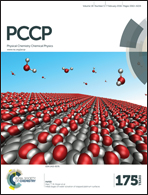Reaction mechanism of a PbS-on-ZnO heterostructure and enhanced photovoltaic diode performance with an interface-modulated heterojunction energy band structure†
Abstract
A room temperature successive ionic layer adsorption and reaction (SILAR) method is introduced for fabricating quantum dots-on-wide bandgap semiconductors. Detailed exploration of how SILAR begins and proceeds is performed by analyzing changes in the electronic structure of related elements at interfaces by X-ray photoelectric spectroscopy, together with characterization of optical properties and X-ray diffraction. The distribution of PbS QDs on ZnO, which is critical for optoelectrical applications of PbS with a large dielectric constant, shows a close relationship with the dipping order. A successively deposited PbS QDs layer is obtained when the sample is first immersed in Na2S solution. This is reasonable because the initial formation of different chemical bonds on ZnO nanorods is closely related to dangling bonds and defect states on surfaces. Most importantly, dipping order also affects their optoelectrical characteristics greatly, which can be explained by the heterojunction energy band structure related to the interface. The formation mechanism for PbS QDs on ZnO is confirmed by the fact that the photovoltaic diode device performance is closely related to the dipping order. Our atomic-scale understanding emphasises the fundamental role of surface chemistry in the structure and tuning of optoelectrical properties, and consequently in devices.


 Please wait while we load your content...
Please wait while we load your content...